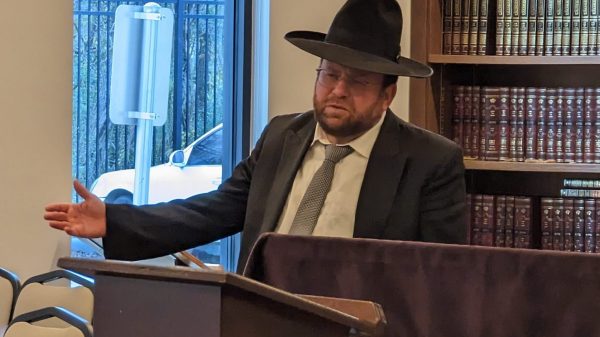Click here to download PDF
לע״נ אמי מורתי האשה החשובה שולמית בת הרב דוב יהודה ע״ה
Bnei Noach
Chazal refer to all good non-Jews as Bnei Noach, while evil goyim are tagged as ovdei cochavim u’mazalot, idol worshippers. This might seem strange seeing as how all of mankind, both Jew and gentile alike, are the descendants of Noach. Why then are gentiles called Bnei Noach, whereas the Jews’ lineage begins with Avraham Avinu?
Why didn’t Noach preach?
Rashi (Bereishis, 6:14) tells us that the purpose of building the ark over a period of 120 years was so people would see him building it and begin to ask questions. He would then be able to warn the populace of the impending flood, sure to come if they would not change their ways. Couldn’t Noach have accomplished more by going on a public speaking tour, instead of passively waiting for people to ask? Avraham went out preaching to the people, proclaiming the name of Hashem. Why the change in approach?
Why did Avraham daven for Sedom?
The prophet named the flood after Noach “mey noach – the waters of Noach,” (Yishayahu, 54:9). This implied that Noach had a certain degree of responsibility for the flood, because Noach didn’t prayer enough on behalf of his generation. He is compared to Avraham, who prayed on behalf of Sedom, trying to save them from destruction. This seems strange. Shouldn’t Avraham have to justify why he would daven to Hashem to rescue such wicked people? Aren’t they just going to continue on their immoral, destructive course if they are saved?
Isn’t it better to be with Hashem?
Noach is referred to as “es HaElokim his’halech Noach” – Noach walked with Hashem” (Bereishis, 6:1). Chazal say this means Noach needed Hashem’s support in difficult times, whereas Avraham walked self-assured, “in front of Hashem.” Seemingly, the pasuk is actually speaking of the virtue of Noach being with Hashem as opposed to being distant and in front of Him, like Avraham who was “running ahead” as opposed to being “with Hashem”.
How do you get someone else’s reward?
The mishna in Pirkei Avos (5:3) says “There were ten generations between Noach and Avraham and Avraham Avinu garnered all their reward.” The prior mishna notes that there were ten generations between Adam and Noach but leaves out any mention of Noach’s reward! Just the fact that Hashem brought the flood. Why didn’t Noach “get all their reward”? Furthermore, what does it mean to “get all their reward”? You get what you deserve in accordance to what you achieved! How do you get “some else’s reward”?
Preserving the Status Quo
The tzadikim before Avraham had no illusions about altering the world’s basic structure. They saw the good and evil that coexisted since Adam HaRishon, and they never dreamed of possessing the power to eliminate evil entirely. They perceived the purpose of their service as stabilizing existence, preventing further decline and deterioration. They envisioned a world where evil is subdued but not extinguished. Nothing lives or lasts forever , so the emphasis was placed on optimal survival, to keep evil “in check”.
Stabilizing
Along these lines, Noach was an “ish tzaddik – a righteous man,” as Mishlei (10:25) says: “tzaddik yesod olam,” a righteous man is the foundation of the world. As the creator of the plow (rashi, Bereishis 5:29), Noach was seen as to the epitome of survival, coping, and the ability to adapt to challenges. Even Noach’s name suggests that he had brought alleviation to the “curse” of the earth, but he didn’t reverse it! He didn’t even try to save his generation, he didn’t think it was possible. Noach was faithful to his perceptions understandings which were the result of whatever Divine energies and revelations he experienced, but he was never able to intellectually venture beyond that “spiritual comfort zone”. That’s what it means “He walked WITH Hashem” clinging close to his perceptions and the spiritual energies he received, never venturing forward to seek a different, higher level.
Shem & Eiver
The Tzadikim that came right after Noach, Shem and Eiver, followed Noach’s approach. They weren’t intending to change the world or anyone’s mind. Shem and Eiver opened a “Beis Medrash” for anyone who was interested to come to them, they did not go out to preach or debate. But it’s more than that. The Radzhiner Rebbe (intro to Beis Yaakov on Bereishis) notes that Malki-Tzedek, who was Shem son of Noach, is referred to as a “priest of the G-d on high”. The global perception at the time saw Hashem as removed and distant from the world. Goodness “trickled down” (see more on this in “Even Shesiya” on Bereishis) from on high but there wasn’t direct intervention to rid the world of evil altogether. The co-existence of good and evil, good guys and bad guys seemed immutable. When Malki-Tzedek meets Avraham, he declares: “blessed is Avram to the G-d on high Possessor of heaven and earth.” Shem saw himself as a worshiper of a somewhat distanced G-d, but he acknowledged Avraham’s role in changing that status quo by bringing G-d consciousness into the world. The Rambam (moreh nevuchim 1:7) explains that the term ben, son, also means disciple and spiritual heir, which in turn determines the level of divine image a man has. Shem, Eiver, and all righteous gentiles continue Noach’s spiritual and ideological legacy of maintaining the world, but not changing it – that’s why they’re called Bnei Noach!
Avraham Avinu- the intellectual adventurer
Avraham’s career as a messenger of Hashem began with walking. The Midrash (Bereishis Rabba, 39:1) describes Avraham’s awakening to Hashem’s presence with the parable of a wanderer walking from place to place who sees a well-lit manor. “Can the building be lit up without a master of the house?,’’ he thinks rhetorically. The seemingly superfluous mention of the traveler hints at the difference between Avraham’s attitude and the rest of his generation. His mind was moving, active, while the rest of the world was content with its old thought patterns and bad habits. The Maharal (Netzach Yisroel chap 5; chiddushei agados Baba Basra 73b) says that “machshava”-thought is the process of the mind moving in thought from level to level and is often described metaphorically by Chazal as “walking”, or “traveling”. Our minds naturally ”travel” or ”wander” and it is our task to discipline and direct our thoughts in the right direction. The Aramaic term for the unit of Talmud which contains the intricate give and take of legal argument is sugya, which also means to walk. The Rambam in Hilchos Avodah Zara (1:3) describes Avraham Avinu as a meshotet b’da’ato, a mind adventurer. He was constantly contemplating the nature of heaven and earth and questioning the prevailing idol worshiping practices.
Boldly going where no mind has gone before
A typical debate between Avraham and others is described in Rambam’s Moreh Nevuchim (3.29) – he saw it recorded in libraries of his time. The idolaters claimed they were sun worshippers because the sun gave them heat, light and makes things grow. He said, “It is just an axe in the hands of the woodchopper; who do you pay – the axe or its wielder?” His metaphor implied that he had asked himself, “What gives the sun the ability to do that?” while his debate partners were not interested in such an inquiry. Ultimately, he was banished because of his revolutionary philosophies.
Do we walk or sit?
With this we can reconcile a contradiction in Chazal. Chazal say (Brachos, 64a) ”Tzaddikim have no rest in this world or the next as it says: they will go from strength to strength”. Obviously, this cannot be referring to a physical state, as travel is not relevant in the world to come. Yet we find that Chazal (Brachos, 17a) also refer to tzaddikim in the next world as “sitting with their crowns on their heads.” It is their intellect that never rests, and they constantly achieve new understanding of Torah as reward for their efforts here. They themselves may be stationary, but their minds are not.
Bnei Avraham
The Jewish people are the heirs of Avraham’s legacy, world rectification. Avraham Avinu began a chain which culminated in Hashem giving the true essence of Torah to Klal Yisrael on Har Sinai. It is true that our mission of rectifying the world and eliminating evil began with the Mitzvos we received as a nation following the exodus, but our national character was already formed by the Avos in general and Avraham in particular – That’s why we’re called Bnei Avraham, Yitzchak, and Yaakov and NOT Bnei Noach!
Where Anti-Semitism started
Avraham initially tried to do this in friendly ways, but ultimately he was referred to as Ivri, the one on the other side. This distinct role of ours is the source of all anti-Semitism. Our enemies constantly gripe about a Jewish conspiracy to control the world. They subconsciously sense that Klal Yisrael is promulgating upheaval, whereas they want to maintain the world’s status quo. We are trying to sway the world from its low-level stability to a higher level of expectation. This results in a type of see-saw kind of existence, along the lines of the Gemora in Megilla which says, “Do not believe anyone who says Tzur and Yerushalayim are simultaneously prosperous.” The goyim may even sense that “Ein puraniyos ba’ah l’olam ela bishvil Yisrael – No troubles (upheavals) come to the world unless they are for the Jews’ sake.” (Yevamos, 63b) This is true because Klal Yisrael needs to be pushed and directed morally to change the world.
Shifting the cosmic balance
When Avraham prayed to save Sedom he was hoping that the prayer itself would inject a metaphysical power of good and righteousness into the world which would influence the wicked population to rethink its inhospitable, selfish ways. He wanted to do more than Noach, who could only think to maintain the status quo.
As we saw from the mishna in Avos, Noach did not receive the reward of the generations prior. This was because he didn’t change the world, he only stabilized its prior condition. Avraham Avinu changed the world, shifting the balance of good and evil, and getting it to lean to the side of good, the side of reinforced existence. He thus pushed evil to the other side, the side of oblivion. The Maharal (Derech Chaim 5:2-3) explains that the way Avraham received the “reward of the generations” was by saving all the sparks of holiness of the generations prior. He saved them, elevated them, and they naturally gravitated to him to be his eternal accomplishment.











